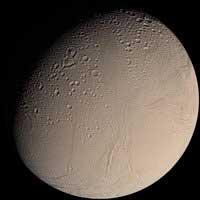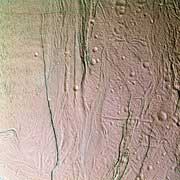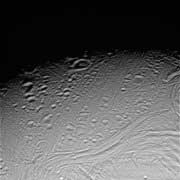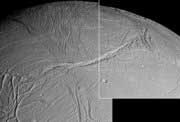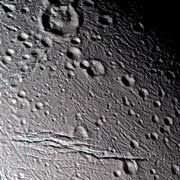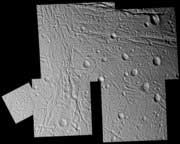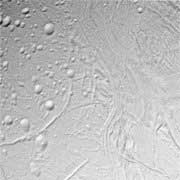|
|
Enceladus (en-sel'-a-dus, Greek Εγκέλαδος) is a moon of Saturn discovered in 1789 by William Herschel. Despite its small size, Enceladus has a wide-range of surface types ranging from old, heavily cratered surfaces to young, very smooth terrain. Given its position in Saturn's E ring, the youthful appearance of portions of Enceladus' surface, the recent discovery of a short-lived atmosphere, and a hot spot near the south pole, it is likely that Enceladus is active today.
Name Enceladus is named after the mythological Enceladus. It is also designated Saturn II. The name "Enceladus" and the names of all seven satellites of Saturn then known were suggested by Herschel's son John Herschel in his 1847 publication Results of Astronomical Observations made at the Cape of Good Hope ([10]).
Physical characteristics
Figure 1: False-color view of Enceladus showing the various terrain types
Interior Relatively little is known about the interior of Enceladus. However, some insights were gained during the recent flybys of Enceladus by the Cassini Spacecraft. Based on the effects of Enceladus' gravity on the Cassini Spacecraft during those flybys, the Cassini Navigation team determined that it has a mass of 1.08x1020 kg which, combined with its known size, yields a mean density of 1.61 g/cm3 (Turtle et al. 2005). This density is higher than Saturn's other mid-sized, icy satellites, indicating that Enceladus is composed of more silicates and iron than those other satellites. With additional material besides water ice, it is possible that Enceladus may have undergone more radiogenic heating, however, no modeling has been performed to see if such heating would be enough to produce the surface features observed. More than likely, however, Enceladus is much too small to be heated by the decay of radioactive material in its interior at present. Enceladus is locked in a 2:1 orbital resonance with Dione, similar to the situation between Io and Europa, and this may provide a tidal heating mechanism; however it is probably insufficient to melt water ice. Enceladus' interior may therefore contain significant amounts of some low-melting point material, like ammonia, instead of pure water, though no such material has yet been found by Cassini's VIMS visual and infrared spectrometer [11]. It is not yet known if Enceladus' interior is differentiated. Careful study of Enceladus' shape and its effect on Cassini's trajectory during very close flybys (like those planned for July 2005 and March 2008) should provide more detailed information on the structure of Enceladus' interior. However, there are fissures, plains, corrugated terrain and other crustal deformations that indicate the interior of the moon may be liquid today, and thus differentiated, even though it should have frozen aeons ago. Furthermore, recent images from the Cassini orbiter show surface features remarkably similar to those of Europa, which may indicate that Enceladus also harbours a subsurface ocean. However, large regions of cratered terrain may also indicate that even if such a sub-surface ocean did exist, it would be patchy and may only exist under a small region of the surface at any given time. Surface General Geology Voyager 2, in August of 1981, was the first spacecraft to take geologically meaningful observations of Enceladus. The title image above shows the highest resolution image taken of Enceladus by Voyager 2. Examination of this mosaic revealed at least five different types of terrain, including several regions of cratered terrain, regions of smooth, young terrain, and lanes of ridged terrain that often border the smooth terrain (Rothery 1999). In addition, extensive linear cracks were observed crossing the smooth and cratered terrain. Given the relative lack of craters within the smooth plains, these regions are relatively young, probably less than 100 million years. This means that Enceladus must have been active very recently with some sort of "water volcanism" or other process that renews the surface. The fresh, clean ice that dominates its surface gives Enceladus the highest albedo of any body in the solar system (Visual geometric albedo of 0.99). Because it reflects so much sunlight, the mean surface temperature is only -201°C. Recent observations during two recent flybys by Cassini on February 17 and March 9, 2005 reveal Enceladus' surface features in much greater detail than the Voyager 2 observations. For example, the smooth plains observed by Voyager 2 have resolved into relatively crater-free regions filled with numerous small ridges and scarps. In addition, numerous fractures were found within the cratered terrain, suggesting extensive deformation since the craters formed. Finally, several additional regions of very young terrain were discovered in areas not well imaged by either Voyager spacecraft, such as the bizarre terrain near the south pole [12].
Figure 2: Degraded Craters on Enceladus, imaged by Cassini, 17 Feb 2005 Impact Craters Impact cratering is a primary process on many solar system bodies, and Enceladus is no different. Much of Enceladus' surface is covered with craters at various densities and levels of degradation. From Voyager 2 observations, three different types of cratered terrain were discovered: the ct1-unit consisting of numerous, viscously relaxed craters, the ct2-unit consisting of slightly fewer, less-deformed craters, and the Cratered plains(cp)-unit consisting of fewer craters that are on average smaller than those making up the other two units (Rothery 1999). Though the ct1 unit is the oldest terrain type on Enceladus given its high density of craters, the crater density in that region is still less than the youngest regions on Saturn's other mid-sized icy satellites, like Rhea, again suggesting that even Enceladus' oldest terrains are younger than most surfaces in the rest of the Saturn's system (except Titan) (Rothery 1999). Recent Cassini observations have provided a much closer look at the last two cratered units, ct2 and cp. These high-resolutions observations, like Figure 2, reveal that many of Enceladus' craters are heavily deformed, either through viscous relaxation, fracturing, or "softening" (Turtle et al. 2005). Viscous relaxation causes craters formed in water ice to deform over geologic time scales. The rate at which this occurs is dependent on the temperature of the ice, warmer ice is less viscous and is thus easier to deform. Viscously relaxed craters tend to have domed up floors or to be recognized as craters only by a raised, circular rim (seen at center just below the terminator in Figure 2). Dunyazad, the large crater seen just left of top center in Figure 4, is another example of a crater on Enceladus with a domed-up floor. In addition, many craters on Enceladus have been heavily modified by tectonic fractures. The 10-kilometer wide crater right of bottom center in Figure 4 is a prime example. In that case, thin fractures, several hundred meters to a kilometer wide, have heavily deformed the rim and floor of the crater. Nearly all craters on Enceladus thus far imaged by Cassini in the ct2 unit show signs of tectonic deformation. These two deformation styles, viscous relaxation and fracturing, demonstrate that, while cratered terrains are the oldest regions on Enceladus due to their high crater retention age, nearly all craters on Enceladus are in some stage of degradation. Crater "softening" can be seen within craters in the cp and smooth plains units (Figure 6). Many of these craters have a smooth appearance, lacking many of the sharp relief features seen within many of Enceladus' tectonic features (though some apparently older fractures also exhibit this "softened" look, like some of those seen in figure at top and at higher resolution in Figure 6). It is not yet known what causes craters to degrade in this way, perhaps some process related to Enceladus' regolith (Turtle et al. 2005). Given the location of many of the "softened" craters, it is possible that the process that smooths out these craters is related to the formation process of many of Enceladus' younger terrains.
Figure 3: Enceladus' Europa-like surface, imaged by Cassini, 17 Feb 2005
Tectonics Voyager 2 found several types of tectonic features on Enceladus, including linear troughs and belts of curvilinear grooves, not unlike the bright grooved terrain found on Ganymede. Recent results from Cassini suggest that tectonism is the dominant deformation style on Enceladus. One of the more dramatic types of tectonic features found on Enceladus are rifts that can run up to two hundred kilometers long, 5-10 kilometers wide, and up to a kilometer deep. Figure 3 shows a typical large fracture on Enceladus cutting across older, tectonically deformed terrain. Another example can be seen running along the bottom of the frame in Figure 4. Such features appear relatively young given their cross-cutting relationships with other tectonic features and their sharp, topographic relief with prominent blue outcrops along the cliff faces. Figure 4: False-color view of Enceladus' surface, showing several tectonic and crater degradation styles. Taken by Cassini on 9 Mar 2005 Another example of tectonism on Enceladus is grooved terrain. These lanes of curvilinear grooves and ridges were first discovered by Voyager 2. These bands often separate regions of smooth plains and more heavily cratered regions (Rothery 1999). The lower portion of Figure 2 and the middle of Figure 6 show an example of this terrain type (in this case, a feature known as Samarkand Sulci), as seen at higher resolution by Cassini. Grooved terrain such as Samarkand Sulci is very reminiscent of grooved terrain on Ganymede. However, unlike the terrain on Ganymede, the grooved lanes on Enceladus are generally much more complex. Rather than parallel sets of grooves as on Ganymede, these lanes can often appear as bands of crudely aligned, chevron-shaped features. In other areas, these bands appear to have a convex cross-section with fractures or ridges running down the length of the feature. Cassini also found intriguing dark, 125- to 750-meter-wide spots, which appear to run parallel to narrow fractures. Currently, these spots are interpreted as collapse pits within these ridged plain belts (Turtle et al. 2005).
Figure 5: High-resolution mosaic of Enceladus' surface, showing several tectonic and crater degradation styles. Taken by Cassini on 9 Mar 2005 In addition to deep fractures and grooved lanes, Enceladus has several other tectonic deformation styles. Figure 5 shows narrow, several-hundred-meter-wide fractures that were first discovered by the Cassini spacecraft. The fractures tend to form subparallel groupings and are found largely within cratered terrain. These fractures tend to demonstrate focusing within craters, suggesting that the propagation of these fractures is heavily influenced by the upper few hundred meters of weakened ground formed during the formation of Enceladus' craters. Another example of tectonic feature on Enceladus are the linear grooves first found by Voyager 2 and seen at a much higher resolution by Cassini. Examples of linear grooves can be found in the lower left of the figure at the very top (seen at higher resolution in the lower left of Figure 6), as well as in Figure 1, running from north-south from top center before turning to the southwest. These linear grooves can be seen cross-cutting other terrain types, like the curvilinear groove lanes, so like the deep fractures, appear to be among the youngest features on Enceladus. However, some linear grooves, like those seen in the image at top and in Figure 6, appear to be softened like the craters nearby. Ridges have also been observed on Enceladus, though not nearly to the extent as those seen on Europa. Several examples can been in the lower left corner of Figure 3. These ridges are relatively limited in extent and are one kilometer tall. One-kilometer tall domes have also been observed (Turtle et al. 2005). Finally, several regions on Enceladus have a background of various styles of tectonic deformation. This tortured terrain, best seen in Figure 3, sometimes appears similar to the ridged plains of Europa (given rise to the suggestion that Enceladus might have a liquid water sub-surface ocean, like Europa), while other areas, like those seen near the top of Figure 3, appear like nothing else in the solar system. Given the level of tectonic resurfacing found on Enceladus, it is clear that tectonism has been an important driver of geology on this small moon for much of its history.
Figure 6: Samarkand Sulci on Enceladus. Taken by Cassini on 17 Feb 2005 Smooth Plains The final terrain type noted in Voyager 2 images are smooth plains. Smooth Plains generally have very low relief and have very few craters, indicating that this unit is quite young, perhaps only a few hundred million years old (Rothery 1999). Cassini has since viewed two of the most prominent regions of smooth plains, Sarandib Planitia and Diyar Planitia at much higher resolution, examples of which can be seen in Figure 1 (left side) and Figure 6 (upper right). Cassini images show smooth plain regions to be filled with low-relief ridges and fractures. These features have currently been interpreted as being caused by shear deformation (Turtle et al. 2005). Images taken by Cassini during the flyby on July 14, 2005 revealed a new type of "smooth" plain. This region, surrounding Enceladus' south pole and reaching as far north as 60° South Latitude, is covered in tectonic fractures and ridges [13]. This region is very young, with no sizable craters visible. Near the center of this terrain are four fractures bounded on either side by ridges, unofficially called "Tiger Stripes". These fractures appear to be the youngest feature in this region and are surrounded by blue-colored, coarse-grained water ice, seen elsewhere on the surface within outcrops and fracture walls [14]. Here the "blue" ice is on flat surface, indicating that the region is young enough not to have been coated by fine-particulates from the E-ring. One of these areas of "blue" ice was observed at very high resolution during the July 14 flyby, revealing an area of extreme tectonic deformation and blocky terrain, with some areas covered in boulders 10-100 meters across [15]. The boundary of the south polar region is marked by a pattern of Y- or V-shaped regions of parallel ridges and valleys. The shape, orientation, and location of these features indicate that the features are caused by changes in the shape of Enceladus. These changes are likely due to changes in Enceladus' rotation rate and orbital distance from Saturn over time [16].
Cryovolcanism Enceladus was confirmed in July, 2005 by a Cassini Spacecraft flyby as the major source of the material in Saturn's tenuous E Ring. According to a July 29 news release[17] from Nasa's Jet Propulsion Laboratory, "Cassini's cosmic dust analyzer detected a large increase in the number of particles near Enceladus. This observation confirms Enceladus is a source of Saturn's E-ring. Scientists think micrometeoroids blast the particles off, forming a steady, icy dust cloud around Enceladus. Other particles escape, forming the bulk of the E ring." Other instruments on the Cassini spacecraft have provided evidence of present day activity on Enceladus. An atmosphere consisting primarily water vapor was found at Enceladus by the Magnetometer and Ultraviolet Imaging Spectrometer instruments. The atmosphere was found to be concentrated over the south polar region, an area with very few impact craters. The composition of the atmosphere is consistent with outgassing or evaporation of water [18]. In addition, the Composite InfraRed Spectromer (CIRS) instrument, during the July 14, 2005 flyby, found a warm region near the south pole. This region was found to have a brightness temperature of 85-90 Kelvin, 15 degrees warmer than expected. In addition, color temperatures of several features in the region indicate small areas at greater than 110 Kelvin, too warm to be explained by sunlight alone [19]. Some areas within the "tiger stripes" maybe as warm as 140 Kelvin [20]. The discovery of a concentration of gas near the south pole, the very youthful age of the surface, and the presence of escaping internal heat, indicate that the south polar region is active today. Scientists officially recognise the following geological features on Enceladus:
See also: List of geological features on Enceladus. Atmosphere In addition to examing the geology of Enceladus, several instruments on the Cassini spacecraft detected an atmosphere at Enceladus. The magnetometer instrument on Cassini observed an increase in the power of ion cyclotron waves near Enceladus. These waves are produced through the ionization of particles within a magnetosphere and the frequency of the waves can be used to identify the composition, in this case ionized water vapour (Burton 2005). Because Enceladus's gravity is too weak to retain an atmosphere, it must be replenished from some source. Although the atmosphere has been described by its discoverers as "substantial", this is only by comparison with most other icy moons; the atmosphere is a million million times thinner than Earth's [21]. Thanks to the very low altitude of the July 14 flyby and improved modeling results of data from the previous two flybys, the magnetometer team determined that gases in Enceladus' atmosphere are concentrated over the south polar region, with atmospheric density away from the pole being much lower. Such a concentration could be the result of outgassing in the very youthful south polar terrain [22]. The UVIS instrument detected an atmosphere during the July 14 encounter, seeing a similar concentration of gasses over the south polar region [23].
Exploration of Enceladus The first spacecraft images of Enceladus were taken by the two Voyager spacecraft. Whereas Voyager 1 only got a very distant look at Enceladus in December 1980, Voyager 2 in August 1981 was able to take much higher resolution images of this satellite, revealing the youthful nature of much of its surface. Detailed reconnaissance would have to wait until the arrival of the Cassini Spacecraft on June 30, 2004, when it went into orbit around Saturn. Given the results from the Voyager 2 images, Enceladus was considered a priority target by the Cassini mission planners, and several targeted flybys within 1,500 kilometers of the surface were planned as well as numerous, "non-targeted" opportunities within 100,000 km of Enceladus. These encounters are listed below. So far, three close flybys have been performed of Enceladus, yielding significant results on Enceladus' surface as well as as the discovery of an atmosphere. Data from the latest flyby on July 14, 2005 are still being analyzed, but early on the highest resolution images of Enceladus suggest that the south polar area is littered with boulders 10-20 meters across, a surface unlike any seen thus far [24].
... | Pallene | Enceladus | Telesto, Tethys, Calypso | ... Saturn's natural satellites
Pan | Daphnis | Atlas | Prometheus | S/2004 S 6 | S/2004 S 4 | S/2004 S 3 | Pandora | Epimetheus and Janus | Mimas | Methone | Pallene | Enceladus | Telesto, Tethys, and Calypso | Polydeuces, Dione, and Helene | Rhea | Titan | Hyperion | Iapetus | Kiviuq | Ijiraq | Phoebe | Paaliaq | Skathi | Albiorix | S/2004 S 11 | Erriapo | Siarnaq | S/2004 S 13 | Tarvos | Mundilfari | S/2004 S 17 | Narvi | S/2004 S 15 | S/2004 S 10 | Suttungr | S/2004 S 12 | S/2004 S 18 | S/2004 S 9 | S/2004 S 14 | S/2004 S 7 | Thrymr | S/2004 S 16 | Ymir | S/2004 S 8 see also: Rings of Saturn | Cassini-Huygens | Themis Retrieved from "http://en.wikipedia.org/"
|
|
|||||||||||||||||||||||||||||||||||||||||||||||||||||||||||||||||||||||||||||||||||||||||||||
